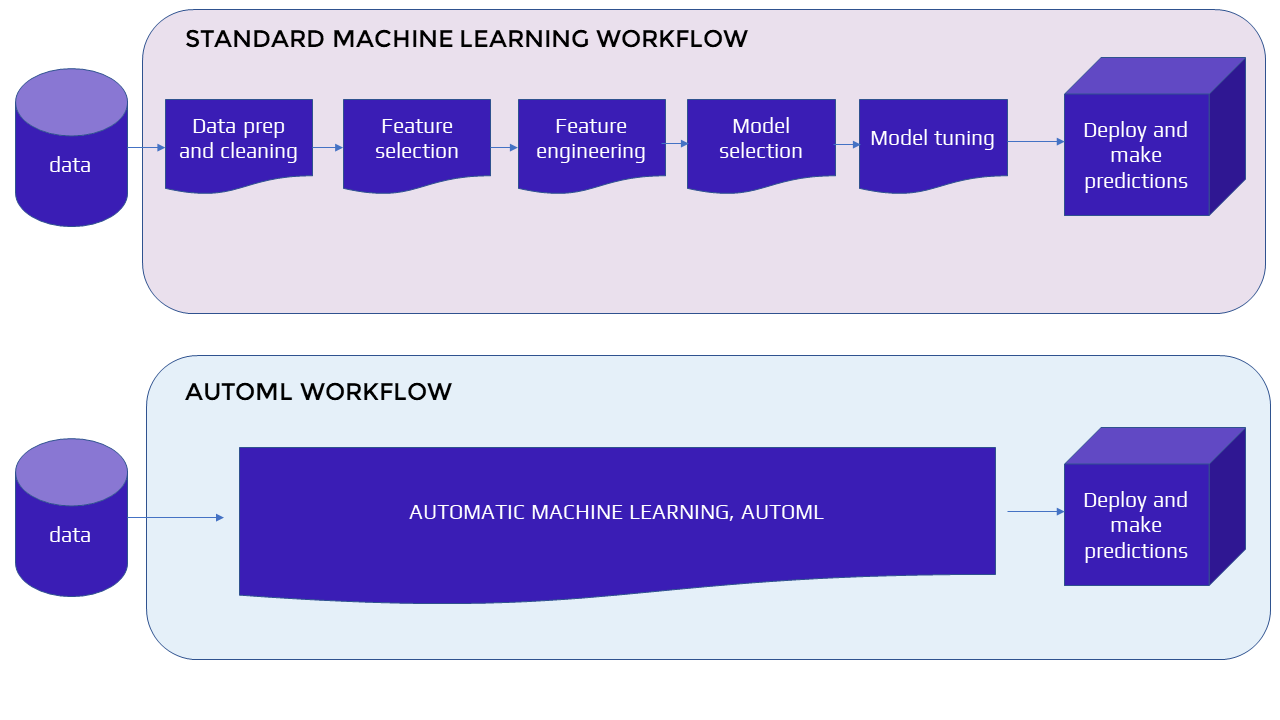AutoML Solutions
AutoML solutions are a cutting-edge technology that revolutionize how artificial intelligence works. AutoML solutions enable machines to learn and improve on their own without the need for human intervention. AutoML solutions leverage the power of artificial intelligence to automate the process of machine learning. This makes machine learning faster, more efficient, and more accurate than ever before. The potential of AutoML Solutions is limitless. AutoML solutions hold enormous promise for industries across the board. Whether you’re a business leader, a data scientist, or just someone who’s curious about the future of AI, this is a field that you want to take advantage of.
This article discusses automated machine learning, how it works, and some of its benefits.
We also explore some challenges in automating the machine learning process.
Artificial Intelligence
Artificial intelligence (AI) is continuously evolving. The applications for AI expand exponentially, every day. AI is a rich field that holds tremendous potential across all industries. Further technological advancements only promise so much more for the future. One of the most recent evolutions in AI is automated machine learning. Automated machine learning is also known as AutoML solutions. AutoML solutions help machines learn and improve their abilities. In this article, we discuss automated machine learning, how it works, and some of its benefits. We also explore some challenges you may face in automating the machine learning process.
What are AutoML solutions?
Automated machine learning uses algorithms to automatically find and use the best possible models for predictive modeling tasks. AutoML is a branch of artificial intelligence that has become increasingly popular in recent years. AutoML helps businesses reduce the costs and time associated with traditional machine learning techniques. A high degree of automation is provided by AutoML solutions, enabling you to build and deploy machine learning models with minimal manual intervention.

Data scientists can use automated machine learning algorithms for various tasks, including:
- Regression.
- Classification.
- Linear models and neural networks are common machine learning models that can be automated using AutoML solutions.
- Time series forecasting. Series forecasting with AutoML enables you to predict future trends and patterns in time series data. Series data models are specifically designed for time series forecasting tasks and can be built with AutoML tools.
- AutoML can be used for a wide range of tasks, including customer churn prediction, fraud detection, and risk assessment.
- Clustering.
AutoML solutions and AutoML algorithms can identify relationships between different variables in data sets. They then use those relationships to predict future events or observations. AutoML solutions streamline the development of machine learning models, making them accessible to businesses without extensive data science expertise. AutoML software automates various tasks in the machine learning process, including data preprocessing, model selection, and hyperparameter tuning. Code automation in AutoML eliminates the need for manual coding, allowing businesses to build models faster and with less technical knowledge. AutoML tools simplify the machine learning process, enabling businesses to leverage the power of AI without requiring a team of data scientists. AutoML platforms offer a user-friendly interface, making it easier for businesses to build and deploy machine learning models.
Predictive models built with AutoML solutions can help you gain key insights from data and make better business decisions.
Automated machine learning is still in its early stages of development. It has, however, shown great promise as a cost-effective and efficient prediction method in real-life business scenarios.
Real World Examples Of AutoML
The field of AutoML solutions continues to grow every day. Here are some real world examples of AutoML solutions:
- Amazon SageMaker is a cloud-based platform that offers AutoML capabilities. This enables you to build and deploy machine learning models on Amazon Web Services (AWS).
- Amazon SageMaker Autopilot is a fully automated machine learning service that builds and deploys models without requiring any coding.
- Databricks AutoML is a cloud-based platform that automates the machine learning pipeline for businesses using the Databricks ecosystem.
- Cloud AutoML solutions offer scalable and cost-effective options for businesses to build and deploy machine learning models in the cloud.
- Open-source AutoML platforms provide businesses with greater flexibility and customization options for their machine learning projects.
- Azure AutoML is a cloud-based service that automates the machine learning process for various business use cases.
- Google Cloud offers AutoML tools alongside its deep learning capabilities, providing a comprehensive platform for building and deploying AI models. Google Cloud AutoML offers a suite of pre-built models for various tasks, including image recognition, natural language processing, and time series forecasting.
What Steps Are Involved in AutoML?
There has been a growing interest in automated machine learning in recent years. The field aims to develop algorithms that automatically select and apply the best machine learning models for a given data set. This saves resources, including time and money, for data analysts and data scientists. Without AutoML, they would need to spend many hours or days tuning parameters and trying different models. There are many different approaches to AutoML, but most of them follow similar steps:
Preprocessing
AutoML algorithms typically preprocess data to make it easier to work with. This may involve
- Scaling numerical features.
- One-hot encoding categorical features.
Feature Engineering
After the data has been preprocessed, the next step is to engineer features. Features are columns in the data set. This step may involve creating new features from existing ones. This step could also involve selecting a subset of features to use in the model. Feature engineering is one of the most critical steps in any machine learning project. Feature engineering takes raw data and transforms it into features that a machine learning algorithm can use. Feature engineering can be time-consuming and tedious, but it is essential for getting good results. Feature engineering is often automated by AutoML solutions, reducing the need for manual data manipulation.
Data scientists use many techniques for feature engineering. The best approach will vary depending on the data and the problem you are trying to solve. Traditional methods include:
- Feature selection. Feature selection can be automated by AutoML solutions. This ensures the most relevant features are used for your machine learning model’s training phase.
- Feature extraction.
- Dimensionality reduction.
By carefully engineering your features, you can significantly improve the performance of your machine learning models.
Model Selection and Tuning
Selecting the proper model is essential to ensure the success of your AutoML process. Once you have chosen the appropriate model, tuning it involves selecting the correct hyperparameters for the model and training it on the data.
Tuning is a critical step for automated machine learning. It is often necessary to experiment with different models and hyperparameters to find the best-performing ones. This can be time-consuming.
There are several ways to tune a machine learning model. Cross-validation is the most common method. Cross-validation involves dividing your data into several parts. You then train the model on each part, one by one. The goal is to find the combination of parameters that results in the best performance on the test set.
Another popular method for model selection and tuning is grid search. Grid search involves systematically trying different combinations of parameters and selecting the one that produces the best results.
Cross-validation and grid search can be incredibly time-consuming. Choosing the correct method for your particular problem is essential for an efficient process.
Model Training
Data is prepared and fed into the algorithms in the model training stage. The aim of this stage is to find the best way to map the input data to the output desired results. This process can be time-consuming and resource-intensive, but it is essential to ensure that the final model is accurate and reliable.
Data scientists use different techniques in model training, and AutoML systems often use various methods to find the most effective solution. Once the model has been trained, it can be deployed to provide predictions on new data.
Model Deployment
Model deployment is the process of taking a trained machine learning model and making it available for use in production environments. This stage can be incredibly challenging. It requires putting the model into production and ensuring it performs as expected.
Deployment is often the most complicated step in the machine learning process. It frequently requires a lot of time and energy from data scientists and programmers.
Once all adjustments are made and the model is ready for deployment, it can help companies make data-centric decisions for their benefit.
What Are the Benefits of AutoML solutions?
AutoML solutions are a branch of machine learning that deals with the automated development of models that can be used for predictive data analysis.AutoML is a method of training algorithms to optimize themselves through experience. By automatically constructing and tuning models, AutoML helps businesses who use machine learning improve their data analysis and operations. AutoML enables these benefits:
- Increased efficiency: AutoML automates the time-consuming and tedious process of machine learning. For example AutoML platforms undertake automated data cleaning, feature engineering, and hyperparameter optimization.This enables data scientists to focus on more important tasks. This can lead to significant time savings and increased productivity.
- Improved Accuracy: AutoML can explore a much wider range of model configurations than humans can. This leads to more accurate results. AutoML can try many different models and parameters in parallel. This would take a human much longer to do. Model architecture selection is often automated by AutoML solutions, which makes it easier for you to find the best model for your specific problem. Machine learning models built with AutoML are typically just as accurate as those built manually by data scientists.
- Reduced Costs: By automating the process of machine learning, AutoML can help reduce the costs associated with manual labor. AutoML can perform tasks faster, more accurately, and with less human intervention than traditional methods.
- Greater Accessibility: AutoML makes AI more accessible to non-technical users. Anyone can create and run machine learning models, regardless of their technical expertise. Learning models with AutoML solutions can be achieved with minimal technical expertise, making AI accessible to a wider audience. This helps to democratize AI and open up new possibilities for businesses and individuals.
- Better Scalability: AutoML can handle larger datasets and more complex models than humans can. AutoML makes it easier to scale machine learning applications. AutoML can process vast amounts of data in a short amount of time, and handle large-scale distributed computing.
- Enhanced Productivity: AutoML enables data scientists to focus on more important tasks. Data scientists can leverage AutoML solutions to focus on strategic tasks while the platform automates the routine aspects of model building. This leads to increased productivity and more effective use of resources, allowing data scientists to make better use of their time and expertise.
Do You Need AutoML solutions?
Automated machine learning opens up new possibilities for AI and will speed up the process of teaching machines.
As automated machine learning becomes increasingly sophisticated, its use will likely become more widespread. Businesses should start preparing to take advantage of this technology. No-code machine learning platforms like Graphite Note empower business users to generate no-code machine learning models without writing a single line of code. This means that anyone, regardless of their technical expertise, can take advantage of the power of AI to drive their business forward. AutoML solutions are a field that is worth paying attention to. It’s an exciting time to be a part of the AI community, and the future looks bright for this technology. With the advancements in no-code machine learning platforms, the accessibility and democratization of AI is becoming a reality, opening up new possibilities for businesses and individuals alike. The future of AI is here, and it’s looking brighter than ever before.





